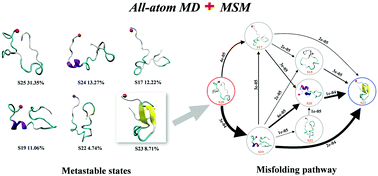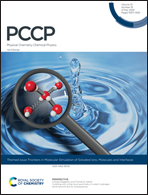The misfolding mechanism of the key fragment R3 of tau protein: a combined molecular dynamics simulation and Markov state model study†
Abstract
The formation of neurofibrillary tangles (NFT) by abnormal aggregation of misfolded microtubule-associated protein tau is a hallmark of tauopathies, including Alzheimer's disease. However, it remains unclear how tau monomers undergo conformational changes and further lead to the abnormal aggregation. In this work, molecular dynamics simulation combined with the Markov state model (MSM) analysis was used to uncover the misfolding progress and structural characteristics of the key R3 fragment of tau protein at the atomic level. The simulation results show that R3 exists in disordered structures mainly, which is consistent with the experimental results. The MSM analysis identified multiple β-sheet conformations of R3. The residues involved in the β-sheet structure formation are mainly located in three regions: PHF6 at the N-terminal, S324 to N327 at the middle of R3, and K331 to G334 at the C-terminal. In addition, the path analysis of the formation of the β-sheet structure by transition path theory (TPT) revealed that there are multiple paths to form β-sheet structures from the disordered state, and the timescales are at the millisecond level, indicating that a large number of structural rearrangements occur during the formation of β-sheet structures. It is interesting to note that S19 is a critical intermediate state for the formation of two target β-sheet structures, S23 and S4. In S19, three regions of V306 to K311, C322 to G326, and K331 to G334 form a turn structure, the regions that form the β-sheet structure in target states S23 and S4, indicating that the formation of a turn structure is necessary to form a β-sheet structure and then the turn structure will eventually transform into the β-sheet structure through key hydrogen bonding interactions. These findings can provide insights into the kinetics of tau protein misfolding.

- This article is part of the themed collection: 2020 PCCP HOT Articles


 Please wait while we load your content...
Please wait while we load your content...